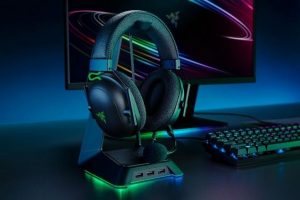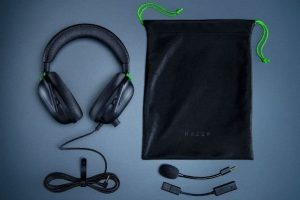
Powerful tones, for enthusiasts
Recognized for the quality of its headsets intended for gamers, Razer has several ranges that it revisits regularly. Today, it’s BlackShark’s turn to switch to “V2”, as the American likes to call his latest updates. USB sound card and THX Spatial Audio are on the menu.
Between the Kraken, Nari and therefore BlackShark, Razer sometimes has a hard time navigating it or, more precisely, clearly directing amateurs to a particular product.The three ranges are indeed designed for gamers and they all have at least on the most ambitious models THX Spatial Audio (7.1) sound. However, the BlackShark V2 is presented by Razer as the best of its headsets for eSports.
Beyond the “stupid” marketing discourse, we have sought to verify the strengths and the shortcomings, there is no reason of this product.Coming out of its box, the BlackShark V2 surprises.
It does not look like any other Razer headset and the American manufacturer is here more sober than usual. The general design of the product leaves little room for accessories, frills.
Related Post : Razer Kraken X Ultralight Review
Structure Material Razer Blackshark
The BlackShark V2 takes the metallic structure of its ancestor – the V1 – but leaves aside all the silver inserts to offer a uniform black dress. The general design of the product is somewhat reminiscent of helicopter pilots’ helmets with a design very different from what is usually found on products intended for video games.
Original design and USB sound card
The padding of the central arch is important, giving maximum comfort to the crown of the head without sacrificing the robustness of the product. Less successful, the height adjustment system of the atria can be imprecise. Nothing too embarrassing, but we would have liked Razer to be more attentive to this level, and we would also have appreciated that the hinges allow these same ear cups to be rotated for even more comfort.
Note that the cables which connect each of them to the rest of the headphones and which are responsible for diffusing the sound constitute the only “extravagance” that the manufacturer has allowed itself: they wear the very bright green characteristic of the brand.

Unsurprisingly, Razer remains faithful to the circum aural type that it favors on most of its ranges and, in particular, on the first version of the BlackShark. On the other hand, unlike the latter, there is no longer any question of imitation leather to dress the ear cups which feature a more classic fabric covering. Nothing to report at this level, perspiration is no problem and the comfort provided is more than honorable you can wear the helmet for several hours without feeling discomfort despite the ambient heat.
The weight, barely over 260 grams, has an important part in the perceived comfort. The right headset is devoid of functionality while the left one has the plug for connecting the flexible microphone boom. On the left ear cup, there is also the microphone on / off button and a large volume control button. If the design can surprise, in full part, it is practical to access it very easily.
Less on consoles
Finally, let us underline the fact that Razer here is satisfied with a wired product. Optionally, you can connect it via the supplied 3.5 mm jack cable (2.1 meters) or add the small USB adapter that contains the THX certified sound card. Please note, USB will only be functional on a PC.
While it is interesting to be able to connect the BlackShark V2 to a wide range of peripherals from a computer to a smartphone via various tablets and game consoles, there are limitations. Indeed, some functions and settings are linked to the use of the sound card integrated into the USB module. In 3.5 mm jack, you will therefore have a more basic headset. Pity.
In the first place, it is the THX Spatial Audio which goes by the wayside. We also lose all the settings present in the Razer Synapse software this goes from a simple audio mixing intended to position the sound around the player to the equalization through the bass boost or normalization functions.
Complete on PC
On a PC, as long as you are using USB, you will therefore have access to these various features. Here we particularly appreciated the “enhancement” options related to the microphone. Thus, “volume normalization”, “vocal clarity” and “ambient noise reduction” are three settings that we recommend that you activate to enjoy a very good recording.
However, we were only partially convinced by the virtues of THX Spatial Audio. On paper, this feature promises 7.1 sound capable of immersing the player in the heart of the action. A function more intended for FPS / TPS enthusiasts than for RTS enthusiasts.
Practice for Razer
In practice, you can rely on profiles already prepared by Razer or adjust things to your own preferences.
The profiles in question are still few 18 when leaving the headset and are limited to a few “major” titles. Such as Apex Legends, Call of Duty, Modern Warfare, Counter Strike Global Offensive or VALORANT.
For our part, we tried the thing on Red Dead Redemption II and Horizon Zero Dawn mainly. Success across the board for everything relating to “environments” whether it is the footsteps of our horse or the noises emitted by the “grazers” that we are preparing to hunt, we benefit from spatialization successful.
Who of audio reproduction?

However, things are less convincing when the action is in full swing. The spatialization then seems more confusing and it is difficult to identify the sound sources more precisely than with a simple stereophony. Let’s say there is a little better, but nothing decisive. Finally, but this is probably more a matter of taste, impossible to compare the rendering of THX Spatial Audio with headphones on the head to a real set even only 5.1 living room in the movies.
See Also : hyperx cloud gaming headset review
We lose a lot of detail, precision, immersion. That said, the comparison is also due to the limits of the audio rendering offered by the BlackShark V2. Razer has based part of its marketing campaign on the integration of new drivers, the 50mm TriForce Titanium that it designed itself. On paper, they should make it possible to better distinguish bass, midrange and treble.
This is partly true. In general, one can have the impression of a finer segmentation of the audio spectrum and in a lot of songs, the voices gain clearly in clarity for example. On the other hand, we find a flaw that. Razer has been dragging since the first version of the BlackShark: a preponderance of bass. In general, the builder seems to be a fan of powerful orchestrations and it shows once again.
IN SUMMARY POWERFUL SOUNDS, FOR AMATEURS
It seems that this powerful, spectacular side is having some success with esports players and this is probably the reason why Razer made this choice. Still, music lovers will be at their expense as soon as a composition, rich, plays on many tones, things are less flattering even by manipulating the equalizer. Finally, a quick comment to evoke the microphone capture. There is hardly any criticism to make Razer has done a very good job. The voices are clear, pleasant and no extraneous noise disturbs. Note also the presence of a rather effective windshield at the end of the pole.
The BlackShark V2 is a well made product that we recommend, however, rather to action game enthusiasts, to those who prefer “big sound”. The mids and highs are certainly better processed, better represented than on the previous generation, but the bass remains dominant. Without being stunning, the THX spatialization is effective. But more during rather calm sequences than in the most speedy moments where we lack a little precision.
On the other hand, and even if it is undoubtedly a question of taste, we find it difficult to recommend this THX Spatial Audio for a movie. Finally, special mention for the comfort that one feels with this helmet on the head. Lightweight, “breathable”, it is more pleasant than many of its competitors, even if the adjustment of the ear cups is a little less precise.
Manual guide & Software Update: Razer Blackshark V2 Manual and Software Update
More About This Headset
WE LIKED:
- Rather successful (somewhat) original design.
- Among the lightest in its class.
- Flexible and detachable microphone.
- Powerful audio rendering, favoring the spectacular.
- Comfort at the rendezvous, effective insulation.
- Microphone pickup quality.
WE DIDN’T LIKE:
- A little a lot of bass.
- Non-detachable cable.
- Fit of the ear cups not ideal.
- Cannot rotate ear cups.
- Less functionality on consoles (3.5mm jack).
TECHNICAL SHEET :
- Price : around 110 euros
- Weight : 262 g
- Connection : wired, 3.5mm jack or USB
- Drivers : dynamic, Razer TriForce Titanium 50mm
- Headphone shape : circum-aural
- Sound spatialization: THX Spatial Audio (7.1)
- Frequency response : 12 Hz – 28,000 Hz
- Microphone : yes, flexible and detachable
- Microphone frequency response : 100 Hz – 10,000 Hz Noise reduction: passive
- Guarantee : 2 years